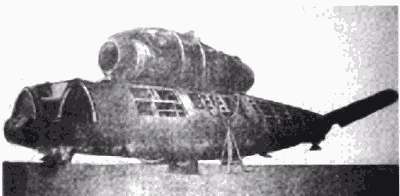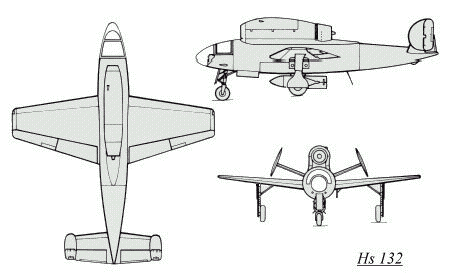 |
The interesting thing about the project was the way the pilot was situated. The pilot was to be placed in a prone position, so as to reduce the effect of G-forces. It worked fantastically. The Hs132 project was commisioned as a dive-bomber.
The roots of the program dated to 1937, when the DVL research into dive-bombing led to the Berlin-Charlottenberg B9 being built to test the idea of a pilot lying prone. Extensive testing throughout the war showed that the advantages were, as said above, fantastic. It also became clear that the frontal area could be reduced.
The Henschel itself was begun in late 1944. The 132A- series was to have a dive-bombing load od 1,102lbs (500kg) with no guns. The 132B, with a Jumo 004 engine was to carry a similar bomb load along with two MG 151 cannon. It was believed that Allied Anti-aircraft bombers would be unable to hit such a small target travelling at such high speed. There were many projected versions, with the C being almost ready.
The factory was occupied by the Soviet Army just as the prototype, V1, was to begin flight testing. If the Henschel would have become active, it would have most likely had the same effect as the Stuka in the early war years. It would be a 500mph terror weapon, to which there would be little or no defense. This once again outlines the luck that the Allies had on their side throughout the war.
|
|
Technical Data
Origin: Henschel Flugzeugwerke AG
Type: Dive-Bomber
Engine: 1,760lb (800kg) thrust BMW 003A-1 Turbojet.
Dimensions: Span 23ft 7.5in (7.20m);
Length: 29ft 2.5in (8.90m);
Height: 9ft 19in (3.00m)
Weights: Empty, not known, loaded 7,496lb (3400kg)
Performance: Maximum speed (with bomb) 435mph (700km/h),
(clean) 485mph (780km/h)
Range: (with bomb, at 32,800ft, 10,000m) 696 miles (1120kms).
Charles Bain
|
 |


